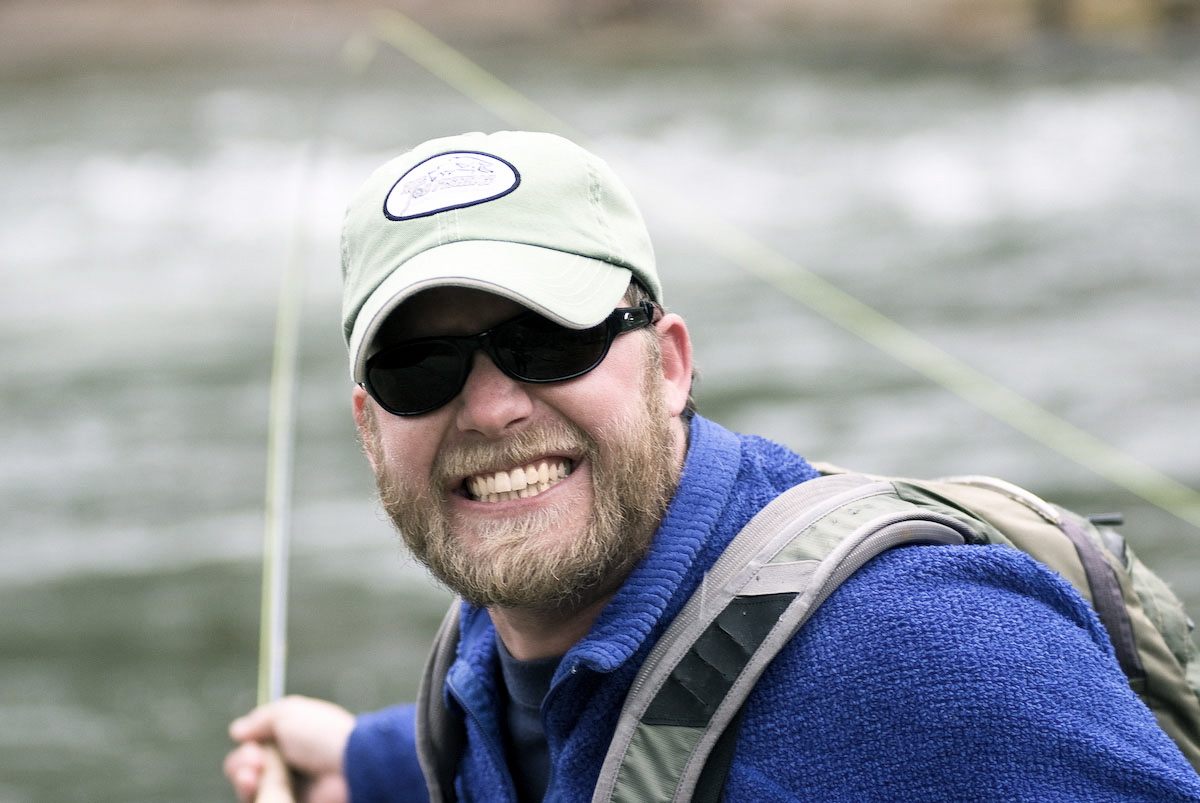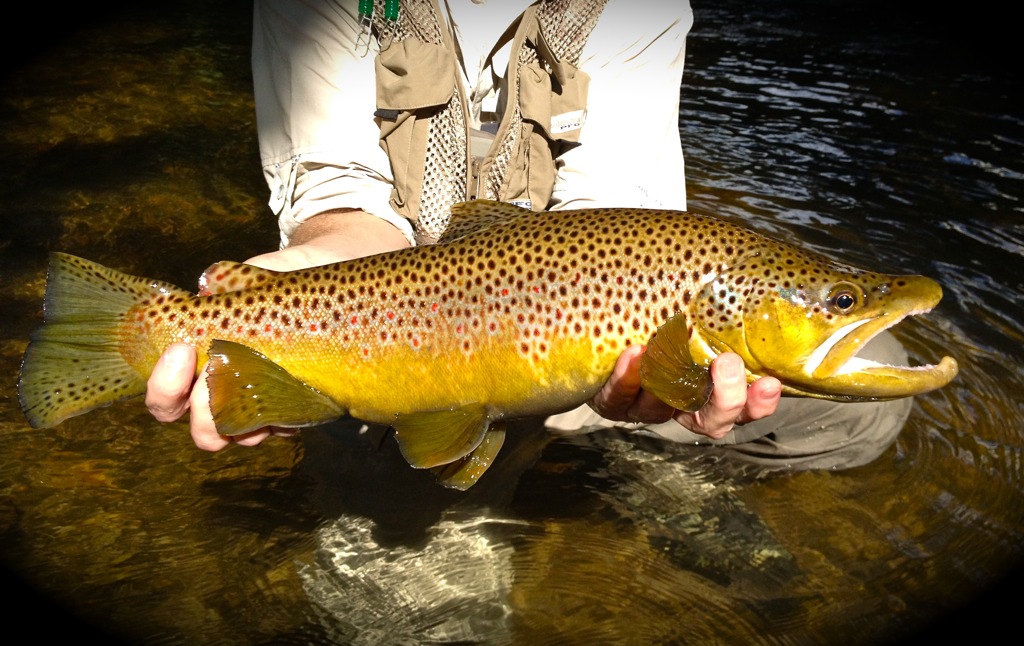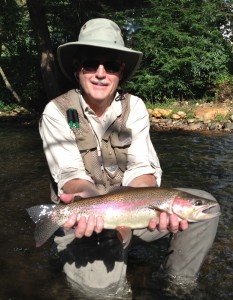By Kent Klewein
The feeling of losing a big trout can be heart breaking.
Especially when it’s a fish of a life time, but it happens to all of us, some just more than others. Most of the time fish are lost because of angler error during the fight, but every once in a while, there’s really no clear identifiable explanation, and all we can do to move forward with a positive attitude, is believe some fish just aren’t meant to be caught. Recently, I had a day on the water where the fly fishing was absolutely epic but no matter how hard my client and I tried, we kept unbuttoning our best fish right before I could get a net on them. At the end of the day, when all the cards had been laid out, I had an epiphany. Below is a break down of the day and my new theory on why certain fish are lost and others are landed.
Some time ago, I had a wonderful day on the water guiding my client David Joiner. He turned out to be a dream client, the kind of client most guide’s would clone and fill up their calendar with if they had the opportunity. The thing that made David such a pleasure to guide was the fact that he was there, first and foremost, to learn. David wanted to catch fish, but it was far more important for him to learn the how-to, so he could then go out and have success fly fishing on his own. This allowed me to really slow down and be thorough with my teachings, and I took the time to describe every detail of the set up and presentation for each spot we fished. I remember early on, David saying to me, “Your the first guide that’s really taken the time to break everything down for me, and that’s what I need if I’m going to take my fly fishing skills to the next level.” His comment of appreciation felt good, and he provided me the freedom to pass on my wisdom any way I saw fit, even if my ramblings ended up costing him some fishing time on the water. If you show your guide your appreciation for his knowledge, he/she will work twice as hard for you and provide you the key fly fishing tips most anglers find difficult to comprehend in books.
A few hours into the day, as I was teaching David how to pre-scan water for trout, I spotted a lone riser out of my peripheral vision.
It rose up from the bottom to inspect something on the surface and it immediately dropped back out of sight, camouflaging itself in the darkness of the deep water. I’ve got pretty good trout eyes, but this twenty-inch trout proved that it doesn’t matter how good an angler’s eyes are at spotting fish, they never will see 100% of fish. David had never caught a trout on a dry fly before, so I suggested we snip off our nymph rig and tie on a beetle pattern I regularly tie and fish with success. Before I gave David the go ahead to make the cast, I warned him to hold off on his hook set until the fish ate and then dropped his nose below the surface. It ended up paying off, because that fish rose up as the beetle entered it’s feeding lane and bumped the fly with its nose (educated trout often do this), but didn’t eat it. Thankfully, David was like Stonewall Jackson, and didn’t budge, and seconds later, that trout made a 180 degree turn and came back and ate the beetle. David stuck it, we both battled the fish on pins and needles, and eventually brought it to net. If we wouldn’t have taken the time to observe the water first, and immediately started fishing, we wouldn’t have been rewarded with that amazing dry fly eat on the surface.
After we landed that beauty on the beetle, we went into a tail spin, losing one big fish after another. It wasn’t that David’s fishing wasn’t up to par, he was fishing great, actually. The trout just kept coming unbuttoned with head shakes before we could get them in. The straw that broke the camel’s back, came from an 1 in 10 shot presentation that David made on the far bank under a bunch of low hanging hemlock bows. A huge rainbow rose from the shadows at the very tail-end of the run and sucked the beetle in. Again, we hooked up and fought the fish for a couple minutes perfectly, but just as we started swinging the fish to the net, the hook popped loose. Both of us moaned out loud with disappointment. Then I looked up to the sky, and quietly but loud enough for David to hear asked God, “Why are you doing this to us? David is a good guy, he deserves to land some of these nice fish.” Moving on to the next whole, God answered my question. On the far bank in a deep, fast riffle, David’s strike indicator signaled a bite and he set the hook. It was quickly apparent this was a big fish, and moments lately, I saw the butter yellow sides of a big brown trout. “Holy crap, that’s a huge brown, I shouted.” A few minutes later, we brought a magnificently colored up wild brown trout to the net that took a black size 16 beetle dropper on our tandem nymph rig.
Wild brown trout like this are few are far between on my home waters.
We catch a handful of them on small streams each year. This guy had been staging at the bottom of a deep riffle as he was waiting to migrate upstream to his spawning grounds in October or November. I forgot to mention this was David’s first brown he’d ever caught? I told him to take his time reviving the fish and to really admire and respect it, because he might not hold another Southern Appalachian wild brown trout like it for years. All smiles and ten thank you’s from David later, we fished our last hole of the day. Drifting his nymph rig along an undercut bank, David set the hook on another big fish. This time it was a big rainbow, but it wasn’t just any rainbow. It wasn’t the usual female hen we regularly catch, this was a big male with a kype just like the brown trout. Yes, indeed, God answered my question on why he let all those previous fish get off of David’s line during the day. He had two very special trout planned for him that day, and he proved to me, at least, that when we lose a big fish, we shouldn’t always lose our minds, and think it’s the end of the world. It’s much better to let it roll off our backs and believe bigger and better things lay ahead. That’s at least what I’m going to start doing on the water. Hopefully, you’ll think of this story next time you find yourself in David’s shoes and continue pressing on with confidence that things will turn around.
Keep it Reel,
Come fish with us in the Bahamas!
Kent Klewein Gink & Gasoline www.ginkandgasoline.com hookups@ginkandgasoline.com Sign Up For Our Weekly Newsletter!



I love that post. I remember writing it with great conviction, honesty and passion. It really was a special day of guiding for me all around that I’ll never forget. I hope the readers find positive ways to learn and relate to the lessons I laid out, and hopefully, it can be used on the next guide trip or DIY fly fishing trip.
Keep it Reel,
Kent Klewein
This brought back fond memories
Great post, thank you. Each time I lose a fish I’m reminded of a quote from John Gierach. “I’ve lost countless fish over the years and none of them were the end of the world, although they all felt like it at the time…it’s just that the one that does get away is suddenly the one you really wanted.”
It was the beetle giving you a hard time. We had 2 trout in a fish tank that we would collect insects to feed them. Most of the bugs were terrestrials, except the worms. Of all the bugs we fed the trout, beetles were eaten and rejected. Eventually the brown would eat the beetle after 6 or 7 chomps. The rainbow never committed to the beetle. Eat and spit about 3 times and then he left it alone. That’s my experience with rainbows and beetles. I thought it was interesting how the trout wanted it, but didn’t really want it. So when I’m fishing beetles I make sure that I am Carl Lewis on the strike, fast!